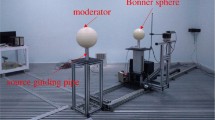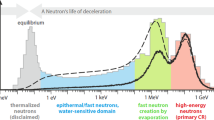In the paper, the necessity for carrying out spectrometric measurements of neutron fluxes in the nuclear industry in order to accurately estimate radiation density and dose characteristics is justified in terms of the inadequacy of current metrological and methodological support for both spectrometric and radiometric measurements of random neutron fluxes. The authors briefly describe the concept of a real-time multidetector neutron spectrometer along with results obtained from a prototype study. In order to increase the reliability of neutron measurements, an innovative concept for verifying a real-time multidetector neutron spectrometer is proposed. This concept involves using several dozens of reference fields exhibiting diverse and precisely known spectra, rather than a single flux, whose spectrum is unknown. The developed testing and verification system is used to carry out a verification. Reference neutron fields produced by this system to exhibit various energetic spectral forms are mathematically modeled. The spectra of the generated reference neutron fields are computed using a system simulated by Monte Carlo software during laboratory tests of a prototype real-time multidetector neutron spectrometer-dosimeter. It is proposed to train a neural network embedded in the multidetector neutron spectrometer-dosimeter on an extended set of basic spectra, which, in addition to the reference field spectra, includes neutron flux spectra reliably known from literature descriptions. A procedure for forming a set of the simulated realizations of training and verification samples used in the neural network training is presented. It is shown that energy errors of the proposed real-time multidetector neutron spectrometer-dosimeter can be avoided during neutron flux measurements, even when performing verification in the reference fields exhibiting a limited variety of spectral shapes. The paper justifies the possibility of minimizing the energy errors of the existing neutron radiometer-dosimeters in the course of the verification performed in the neutron reference fields of the developed testing and verification system.




Similar content being viewed by others
References
F. D. Brooks and H. Klein, “Neutron spectrometry – historical review and present status,” Nucl. Instrum. Meth. Phys. Res. A, 476, 1–11 (2002).
D. I. Thomas, Spectr. Rad. Protect. Dosim., 110, No. 1–4, 141–149 (2004).
Yu. I. Bregadze, E. K. Stepanov, and V. P. Yaryna, Applied Metrology of Ionizing Radiation, Energoatomizdat, Moscow (1990).
M. Matske, “Propagation of uncertainties in unfolding procedures,” Nucl. Instrum. Meth. Phys. Res. A, 476, 230–241 (2002).
V. A. Agupov, R. R. Balyaeva, E. S. Kopeikina, and N. P. Menyailo, “Uniform procedure for certifying typical standard neutron systems,” ANRI, No. 1 (72), 21–27. (2013).
P. F. Maslyaev, “Generation of neutron fields by radionuclide neutron sources,” ANRI, No. 4 (71), 32–38 (2012).
P. F. Maslyaev, “Consideration of factors affecting the verification of systems with radionuclide neutron sources,” ANRI, No. 2 (85), 2–9 (2016).
Compendium of Neutron Spectra and Detector Responses for Radiation Protection Purposes, Tech. Rep. Ser. No. 403, Suppl. to Tech. Rep. Ser. No. 318, IAEA, Vienna (2001).
V. D. Sevast’yanov, Simulated Reference Neutron Fields for the Metrological Support of Neutron Measurements in Russian Nuclear Systems monograph, S. I. Donchenko (ed.), VNIIFTRI, Mendeleevo (2015).
S. Itoh and T. Tsunoda, “Neutron spectra unfolding with maximum entropy and maximum likelihood,” J. Nucl. Sci. Technol., 26, No. 9, 833–843 (1989).
V. E. Dreyzin, A. A. Grimov, and D. I. Logvinov, “Real-time multidetector neutron spectrometer,” Zh. Prikl. Spektrosk., 83, No. 3, 462–468 (2016).
V. E. Dreyzin, D. I. Logvinov, and A. A. Grimov, “Scintillation neutron detectors exhibiting various spectral characteristics,” Zh. Prikl. Spektrosk., 83, No. 6, 953–958 (2016).
B. M. van der Ende, J. Atanachovich, and A. Erlandson, Nucl. Instrum. Meth. Phys. Res. A, No. 820, 40–47 (2016).
Author information
Authors and Affiliations
Corresponding authors
Additional information
Translated from Izmeritel’naya Tekhnika, No. 5, pp. 53–60, May, 2021.
Rights and permissions
About this article
Cite this article
Dreyzin, V.E., Logvinov, D.I., Grimov, A.A. et al. Reliability Assurance of Neutron Flux Measurements. Meas Tech 64, 405–413 (2021). https://doi.org/10.1007/s11018-021-01946-w
Received:
Accepted:
Published:
Issue Date:
DOI: https://doi.org/10.1007/s11018-021-01946-w




